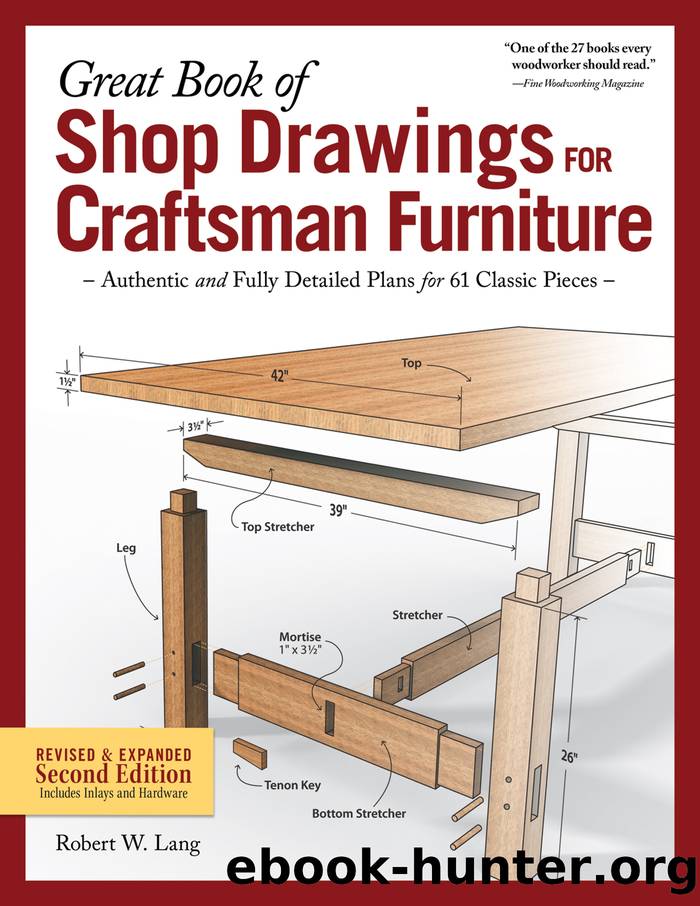Great Book of Shop Drawings for Craftsman Furniture, Revised & Expanded Second Edition by Lang Robert W.;

Author:Lang, Robert W.;
Language: eng
Format: epub
Publisher: Fox Chapel Publishing
Original examples in maple have a dark finish, and are rarer than oak.
UPHOLSTERY
In the drawings in this book, upholstered seats are shown without much detail. While this could be attributed to laziness on my part, there are good reasons for this fuzziness. The original pieces of furniture used several different types of cushionsâsome of them appear to be changes in manufacturing methods over time, while others likely were optional ways of ordering the furniture. Also, the seat cushions are the least durable part of old chairs and settles, so original examples are often seen either with the cushions missing entirely, or with some sort of replacement cushion or support. If you are making chairs or settles, you will need to make your own decision based on your own desire for comfort, and your skills and budget.
Upholstering is a distinct trade from woodworking, and I will confess that I am far from an expert. Slip seats on dining chairs are relatively simple to produce, and are not very demanding. Large cushions on settles and Morris chairs, with their necessary supporting structure, are more involved, and I think the best advice for the do-it-yourselfer is to either take a class on techniques, or hire someone competent to perform this work. I will review the basic methods and materials, and leave a more detailed description of how to do it to those more experienced than me. Van Dykeâs Restorers (800-558-1234, www.vandykes.com) is a good source both for supplies, and for reference material. Local community colleges and vocational schools often offer classes in upholstery, and this would be a good way to learn the fine points, and to get access to needed tools and machinery capable of sewing leather and other upholstery fabrics.
The simplest cushions are found in dining chairs. Usually these were a slip seatâleather wrapped around a padded wooden frame, attached to the frame of the chair itself by screws from below, usually through corner blocks. Occasionally, the frame and padding was attached to the chair before the fabric, and the leather was fastened to the outside of the chair frame with decorative tacks. Morris chairs, large easy chairs, and settles had a greater variety of cushions, and exhibit more changes over time with new technologies and production methods.
Slip seats are simple to make. A hardwood frame, of pieces ¾" by 1¾" to 2", is made to fit inside the frame of the chair itself, with an allowance around the edges for the fabric. A piece of plywood could be used, but the open area in the inside of the hardwood frame will allow air to circulate through the padding and fabric. It also looks nicer if anyone ever peeks under your chair.
If you use an open frame, place webbing across the opening to keep the padding from falling through, and to provide support in the middle of the seat. Padding comes next, and depending on the choice of materials, it can be either glued or tacked in place. It is easiest to wrap the fabric around the seat if it is placed good side down on a clean bench or table.
Download
This site does not store any files on its server. We only index and link to content provided by other sites. Please contact the content providers to delete copyright contents if any and email us, we'll remove relevant links or contents immediately.
| Automotive | Engineering |
| Transportation |
Whiskies Galore by Ian Buxton(41813)
Introduction to Aircraft Design (Cambridge Aerospace Series) by John P. Fielding(33049)
Small Unmanned Fixed-wing Aircraft Design by Andrew J. Keane Andras Sobester James P. Scanlan & András Sóbester & James P. Scanlan(32731)
Craft Beer for the Homebrewer by Michael Agnew(18124)
Turbulence by E. J. Noyes(7921)
The Complete Stick Figure Physics Tutorials by Allen Sarah(7291)
Kaplan MCAT General Chemistry Review by Kaplan(6852)
The Thirst by Nesbo Jo(6811)
Bad Blood by John Carreyrou(6525)
Modelling of Convective Heat and Mass Transfer in Rotating Flows by Igor V. Shevchuk(6378)
Learning SQL by Alan Beaulieu(6192)
Weapons of Math Destruction by Cathy O'Neil(6117)
Man-made Catastrophes and Risk Information Concealment by Dmitry Chernov & Didier Sornette(5904)
Digital Minimalism by Cal Newport;(5633)
Life 3.0: Being Human in the Age of Artificial Intelligence by Tegmark Max(5447)
iGen by Jean M. Twenge(5352)
Secrets of Antigravity Propulsion: Tesla, UFOs, and Classified Aerospace Technology by Ph.D. Paul A. Laviolette(5299)
Design of Trajectory Optimization Approach for Space Maneuver Vehicle Skip Entry Problems by Runqi Chai & Al Savvaris & Antonios Tsourdos & Senchun Chai(4996)
Electronic Devices & Circuits by Jacob Millman & Christos C. Halkias(4890)
